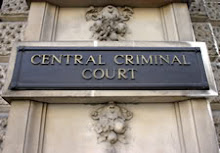Happy birthday, Old Bailey, opened 100 years ago today.
The chequered history of the building that has come to represent a commitment to justice and the rule of law.
February 27, 2007 The Times online( by Gary Slapper)
The Old Bailey is probably the most famous palladium of justice in the world. The Lady of Justice, covered in gold leaf, has become a universal symbol of the rule of law and the proper administration of justice. Significant cases from across the nation are tried there, including a third to a half of all murders. The court has 15 permanent judges; it hears about 400 cases a year, and the average hearing time for a case is 79 hours. Many remarkable trials have occurred in its rooms.
It is 100 years ago today since a new courthouse for the Old Bailey, the Central Criminal Court in London, was opened by Edward VII. By 11am, thousands of people had gathered to watch the ceremony. The courthouse was built and paid for by the Corporation and City of London, which still provide for its upkeep a century later.
Historically, the cases of prisoners held at Newgate gaol, a London prison since the 13th century, were heard by judges in eight annual sessions of the commissions of “oyer and terminer” (to hear and determine). Because there was no dedicated courthouse for such trials, the corporation of the city would hire rooms close to the prison so that prisoners could conveniently be brought to the courtroom.
In 1539 the Court of Aldermen resolved to build a special courthouse in the street called Old Bailey — it followed the line of the original fortified wall, or “bailey”, of the City. This court, first destroyed in the Great Fire in 1666, was rebuilt several times before the 1907 building was constructed.
In earlier centuries, sweet-smelling herbs were distributed throughout the courts or carried in bouquets by judges as an antidote to the pestilent odours from the adjacent Newgate gaol. The sessions of oyer and terminer were abolished in 1834, and replaced by sittings of a new and permanent Central Criminal Court. The current buildings were designed by Edward Mountford and opened on the site of Newgate gaol (which was demolished in 1902).
Most of the million cases so far tried at the court are not well known. They are like that of Elizabeth Gray who, 300 years ago, in January 1707, was convicted of “simple grand larceny” of 40 shillings worth of clothes, and ordered to be whipped.
Many cases, though, have become renowned. In 1895, three trials of Oscar Wilde held the public attention. After his failed libel action against the Marquess of Queensbury, Wilde was prosecuted for, and eventually convicted of, gross indecency offences, and sentenced to two years’ penal servitude with hard labour. His courtroom wit was bountiful. Asked by the seasoned 44-year-old prosecutor Charles Gill whether he exalted youth, Wilde said he did, and added: “I should enjoy, for instance, the society of a beardless, briefless barrister quite as much as that of the most accomplished QC.” He was asked later whether his habit of giving cigarette cases to working-class youths was not strangely expensive. Wilde replied that it was “less extravagant than giving jewelled garters to ladies”.
The hundreds of other famous Old Bailey trials have included those of Dr Crippen and his mistress in 1910, William Joyce (Lord HawHaw) in 1945, the Kray Twins in 1969 and Peter Sutcliffe (“the Yorkshire Ripper”) in 1981. In 2001, Jeffrey Archer was found guilty of lying in his 1987 libel case against the Daily Star (in which he had won £500,000 damages), convicted of perjury and perverting the course of justice, and jailed for four years. Sentencing him, Mr Justice Potts said that the case involved “as serious an offence of perjury as I have had experience of and have been able to find in the books”. The Soham murder trial attracted worldwide interest so a CCTV relay was organised for the journalists who could not get into the court.
The thoughtful design of the 12 modern courtrooms, opened in 1972, evolved in line with social ideas about justice. The 18th-century courtroom was designed to accentuate the conflict between the accused and the court. The accused stood at the bar, opposite the witness box. A mirrored reflector hung above the bar, in
order to reflect light from the windows on to the faces of the accused. This was to allow the court to study their facial expressions when evaluating the reliability of their testimony. A sounding board was positioned over their heads to amplify their voices.
When the courthouse was rebuilt in 1774, one innovation was a dedicated witness room. Witnesses no longer had to repair to a local public house while waiting to testify — something that, despite the attractions for justice of the principle in vino veritas, would have impaired the clarity of some late-afternoon testimony.
In his speech marking the inauguration of the new buildings in 1907 — reported by The Times, which also recorded the crowd reaction — Edward VII said: “The barbarous penal code which was deemed necessary 100 years ago has gradually been replaced in the progress towards a higher civilisation by laws breathing a more humane spirit and aiming at a nobler purpose (Cheers).” The King went on to say: “It is well that crime should be punished but it is better that criminals should be reformed. (Cheers).” Politicians today, who seek crowd cheers by appealing to the ruthless punishment principles of 1807, have some thinking to do.

No comments:
Post a Comment